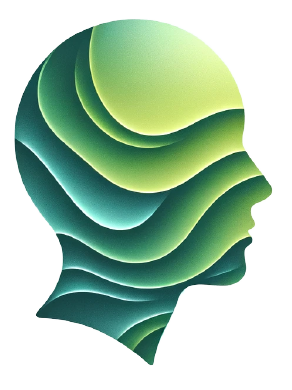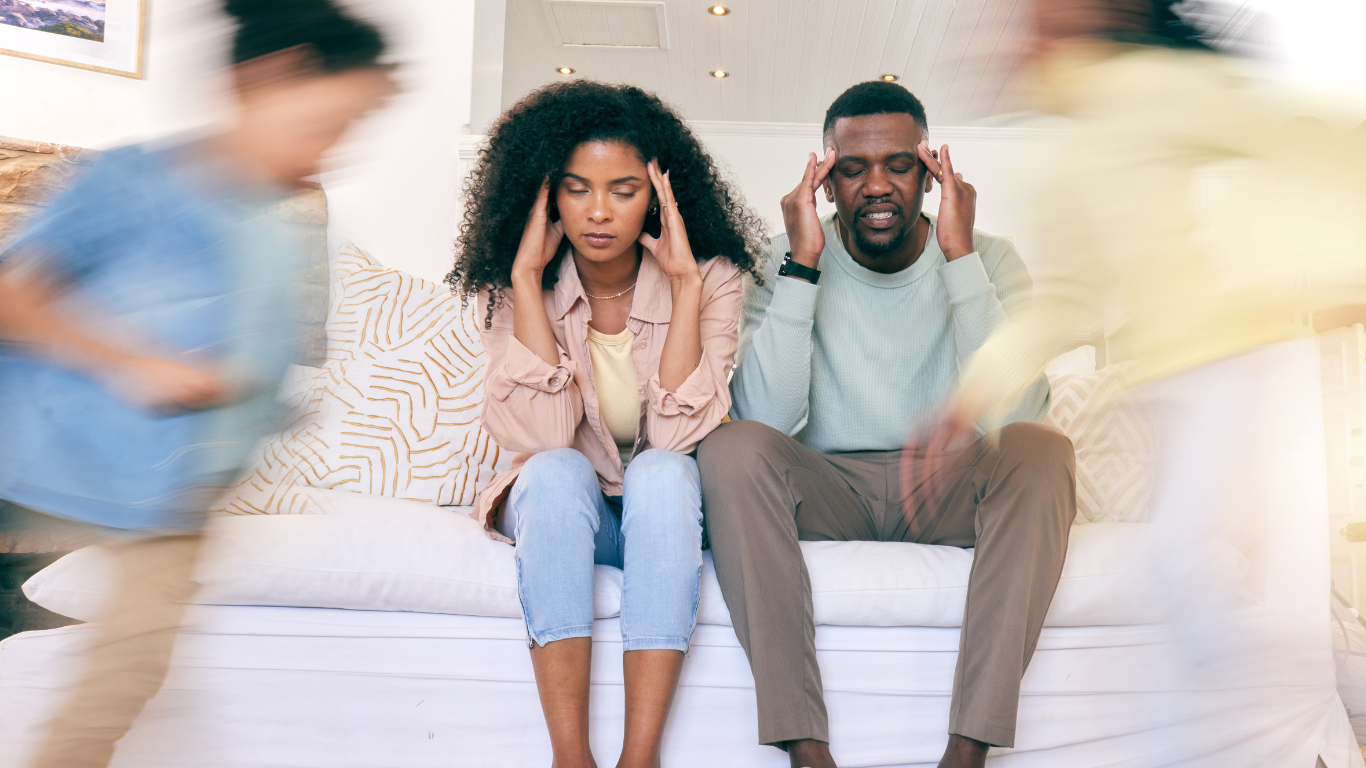Understanding Migraines in Children: Symptoms, Impact and Treatments
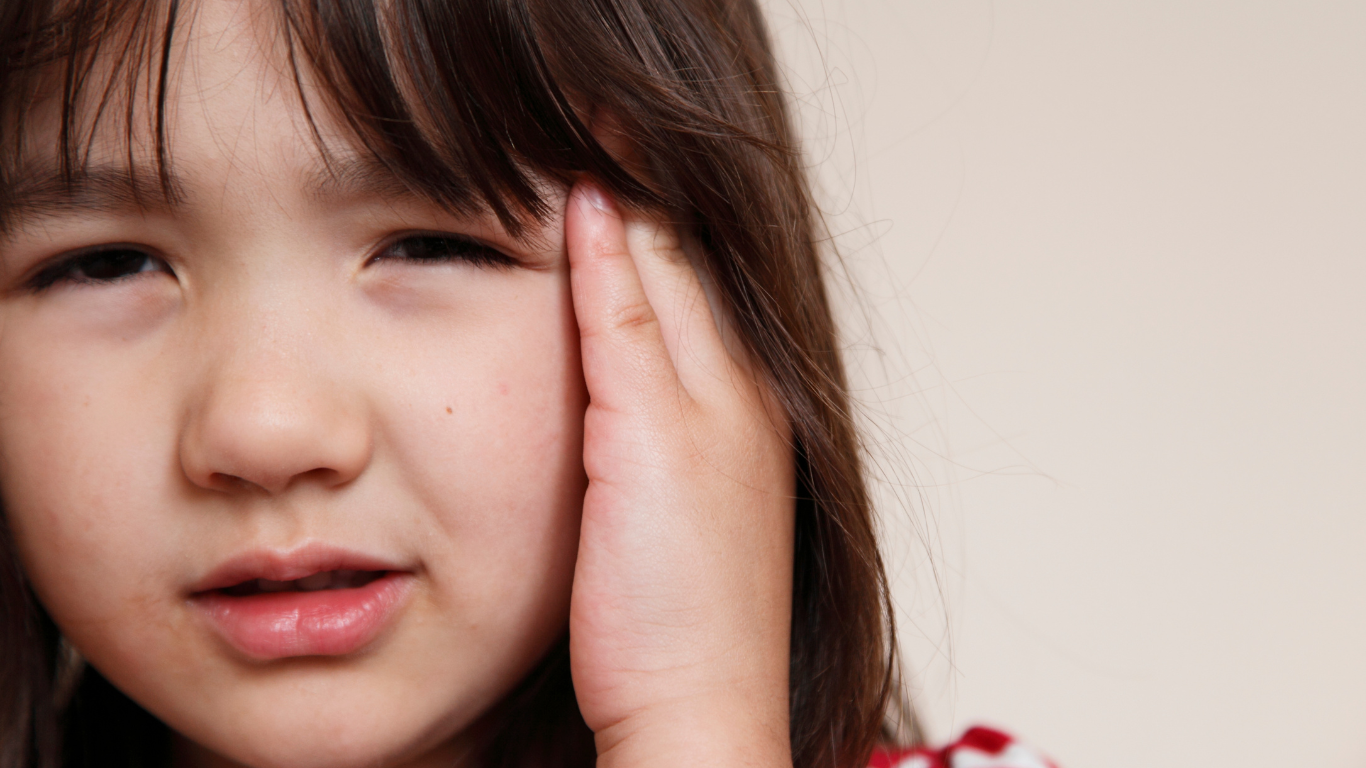

Migraines are often perceived as an adult ailment, but migraines in children do occur. In fact, about 1 in 10 children experience recurrent headaches due to migraine. Symptoms of up to 18% of patients in the pediatric emergency room are found to be migraine-related.1 However, childhood and adolescent migraines look different than adult migraine — often with symptoms other than headache. Migraine triggers in kids can also differ from common adult triggers. Because of this, children’s migraine symptoms can go untreated, with a profound impact on a child’s physical, academic and social well-being.
Key takeaways
- Migraines in children can manifest as headaches, stomachaches, and other symptoms.
- Early diagnosis of headaches in children is important.
- Pediatric migraine treatment should consider the migraine, school performance, and social aspects of the child’s life.
- Pediatric migraine treatment should include acute medication and natural prevention strategies, such as lifestyle changes, diet, and resilience building.
Children’s Migraine Symptoms
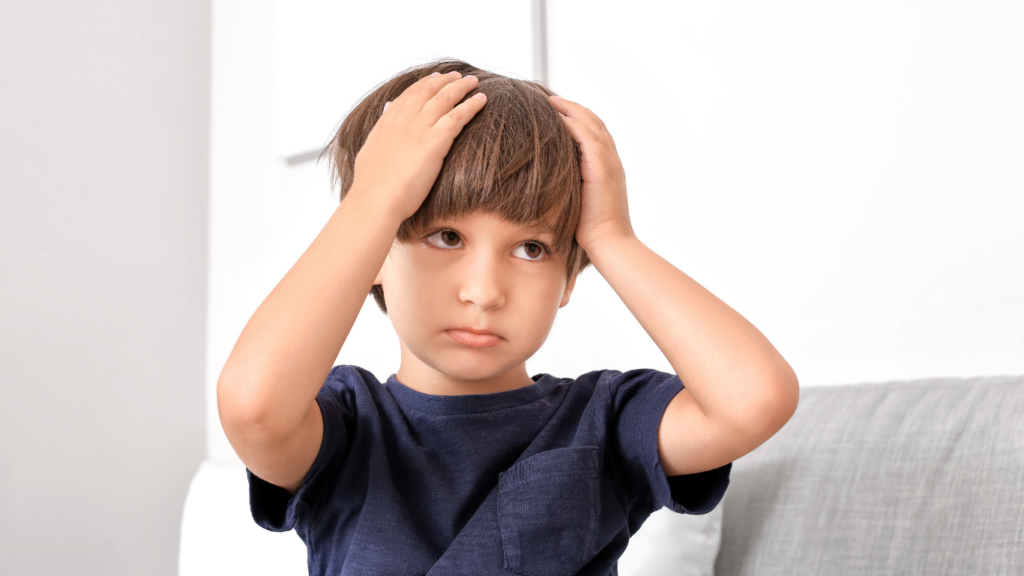
Migraines can look very different for children compared with adults. In fact, for some children, the worst symptoms of migraine may not even be headache but a stomachache or nausea. The pain caused by a migraine can be different, too. Understanding these differences is a critical starting point for figuring out what’s going on and how to get your child some relief.
Compared to adult migraines, children’s migraines:
- Feature shorter, compressed attacks: With children’s migraines, attacks sometimes last less than an hour. The attacks can come on very quickly —often going from the first warning of a migraine to intense pain in just 15 minutes. Relief can be just as fast: For example, even 15 minutes of sleep can be enough to help ease off a child’s migraine.
- Include whole-head pain: In adults, migraine pain is typically on just one side of the head. In children, especially younger children, the pain can often affect both sides.
- Are not just “in their heads:” For some children, there may be no actual headache, or it may not be the main symptom. Instead, they may experience aura symptoms such as disturbed vision, dizziness, fatigue, or sensitivity to loud noises or bright light that lead to pain in the abdomen or nausea. Car sickness may be an indicator of migraine. Sometimes, vomiting may actually bring relief from the migraine attack.
- Are often misdiagnosed: Doctors may address a child’s dizziness, nausea, vomiting, anxiety, disturbed sleep and other symptoms without noting that pediatric migraine treatment is needed.
- Can’t always be treated with adult medicines: Caution must be used even with over-the-counter medications like ibuprofen or acetaminophen. A variety of drugs are used as preventives, but they can have significant side effects for children. This is why treatment with migraine prevention drugs is only FDA-approved for adults.
It’s essential for parents and caregivers to recognize these symptoms, especially since children may have difficulty articulating their pain accurately.
Migraine with Aura in Children
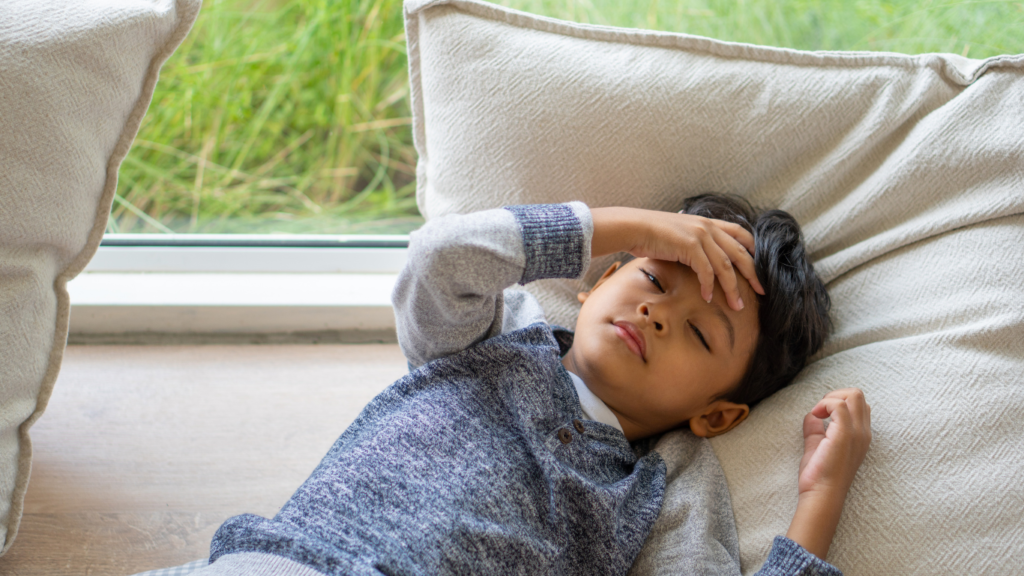
About 10% of children with migraine experience aura. An aura is visual or sensory changes that happen just before the actual migraine starts. Auras can include visual disturbances like flashing lights or zigzag lines. Children may also be sensitive to light or smell, develop tingling of the lips or temporarily lose part of their vision. Experiencing migraine aura, children may be quite distressed by the symptoms.
Ocular Migraines in Children
Ocular migraines, sometimes called retinal migraines, are a type of migraine with aura that only affects one of your eyes. A migraine with aura affects both eyes. Adults may experience ocular migraines as pain surrounding the eye, sometimes with symptoms such as droopy eyelids, double vision, and other sight problems. ocular migraines in children can occur without any noticeable accompanying head pain.2
Abdominal Migraines in Children
Abdominal migraines in children are a subtype of migraine that occur in about 4% of children, affecting the abdomen rather than the head. Children with abdominal migraines often complain of severe stomach pain near the bellybutton that can be accompanied by nausea, vomiting, and loss of appetite. These episodes can be debilitating and may interfere with the child’s daily activities. While children typically outgrow abdominal migraine, they may go on to develop chronic migraine as adults.
Explanation and reassurance are the first step with abdominal migraines. Prevention, in children, should emphasize nonpharmacologic treatment options including avoidance of triggers, behavior therapy, and dietary modifications should be the initial line of management. Drug therapy should be considered only if symptoms do not respond to these primary interventions.
Children’s Migraines: School Performance
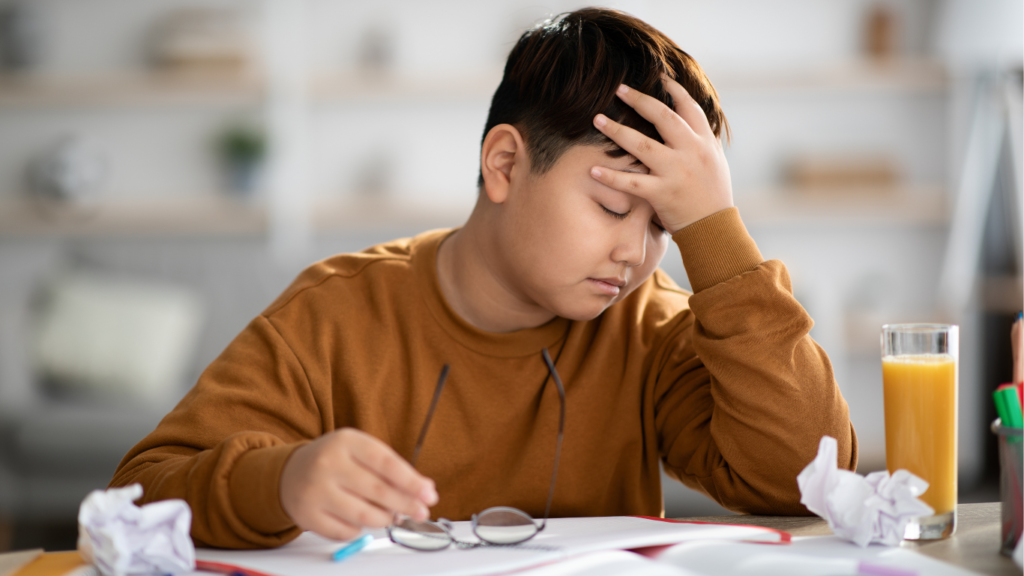
For children and adolescents, academic success plays a crucial role in their development. School is also an important social environment. Unfortunately, migraines can disrupt both, leading to a decline in school performance. Impact of migraines on school performance include:
- Missed School Days: Migraine attacks can cause severe pain, nausea, and other symptoms that make it challenging for children to attend school regularly. Frequent absences due to migraines can result in missed lessons, incomplete assignments, and difficulty keeping up with peers.
- Reduced Concentration and Focus: During a migraine attack or even in the prodromal phase, children may experience cognitive difficulties, including poor concentration, memory problems, and reduced ability to focus on tasks. These cognitive impairments can hinder their academic performance and make it challenging to absorb new information in class.
- Impaired Social Interaction: Children with migraines may experience social isolation or feelings of exclusion from their peers due to their condition. Missing out on school activities, such as sports events or group projects, can further exacerbate feelings of isolation and hinder their social development.
- Academic Stress: The unpredictability of children’s migraine symptoms can add an extra layer of stress for children, especially when they worry about falling behind in studies or disappointing their teachers and parents. This stress can contribute to anxiety and depression, further affecting their academic performance and overall well-being.
Migraines and Learning Disabilities
While children’s migraines themselves are not considered learning disabilities, there is a potential association between migraines and certain learning difficulties:
- Cognitive Impairments: Migraine in children can cause transient cognitive impairments, such as difficulties with memory, attention, and processing speed. These cognitive deficits may interfere with a child’s ability to acquire and retain new information, leading to academic challenges.
- Educational Impact: Migraines in children may interfere with tasks that require sustained attention, concentration, and problem-solving skills, such as reading comprehension, mathematics, and writing. As a result, headache disorders in children may require additional support or accommodations to succeed academically.
- Overlap with Other Conditions: Some children with migraines may also have conditions that are associated with learning disabilities, such as attention-deficit/hyperactivity disorder (ADHD), dyslexia, or developmental disorders. The combination of children’s migraine symptoms and underlying learning difficulties can further complicate the educational journey.
Pediatric Migraine Treatment
Children can’t always be treated with adult medicines. For example, caution must be used even with over-the-counter medications like ibuprofen or acetaminophen. A variety of drugs are used as preventives, but they can have significant side effects for children. This is why treatment with migraine prevention drugs is generally only FDA-approved for adults. Because of this, prevention is the first path to try — and natural options are the first things to try. Here are pediatric migraine treatments that emphasize natural prevention.
- Children’s migraine triggers. Keep a diary or headache diary for your child. Keep track of meals, foods, activities, environmental settings and other possible migraine triggers. Note when a migraine occurs and your child’s migraine symptoms and how long the attack lasts.
- Diet and children’s migraines. Eating regular meals can help avoid spikes and dips in blood sugar that can trigger migraines. Staying well hydrated is critical for all children, but particularly for those who suffer migraines.
Many children’s diets do not include enough green, leafy vegetables, nuts and other sources of magnesium. Even a mild magnesium deficiency can contribute to problems like agitation, anxiety and tummy troubles. There is also a link between magnesium deficiency and migraines. Ask your doctor if your child is getting enough magnesium. He or she may recommend a well-researched dietary supplement such as Dolovent™ that provides magnesium plus other nutrients for brain and whole-body health —and has been used safely for children for many years. - Regular sleep. Just as a 15-minute nap may be able to ease off children’s migraines, regular nightly sleep can help prevent them. From age six through twelve, children need 9-12 hours of sleep daily. Teenagers require 8-10 hours of sleep. And that means sleep — not lying in bed scrolling and texting on phones and tablets.
- Migraine preventatives. Periactin is the brand name for an antihistamine (cyproheptadine) that has long been used as a preventative medication for migraines in children. Amitriptyline is one of the most-used drugs for preventive treatment of pediatric migraine. However, both drugs come with side effects and serious risks, especially for children. Nutraceuticals are a promising alternative for young patients.
One of the most trusted nutraceuticals recommended by doctors is Petasites Hybridus, a patented butterbur extract with the brand name Petadolex®. This herbal supplement has been on the market for decades, used safely by children as young as age six. Like Periactin, Petadolex has antihistamine properties and its efficacy is comparable to CGRP injectable medications. (See following information on a key research study with children.) - Addressing migraines in the school setting. Recognizing the impact of migraines on school performance and learning disabilities is the first step in supporting affected children. Schools can play a vital role in creating a supportive environment for students with migraines by implementing the following strategies:
- Educational Accommodations: Providing accommodations, such as extended time for assignments and tests, access to quiet spaces for rest or recovery during the school day, and flexibility in attendance policies, can help mitigate the impact of migraines on school performance.
- Communication and Collaboration: Establishing open communication channels between parents, teachers, school nurses, and healthcare providers is essential for identifying children with migraines and developing individualized support plans tailored to their needs.
- Promoting Migraine Awareness: Educating school staff, students, and parents about children’s migraines, including children’s migraine symptoms, migraine triggers, and management strategies, can help reduce stigma, foster empathy, and create a supportive school community for children with migraines.
- Encouraging Self-Advocacy: Empowering children with migraines to advocate for themselves and communicate their needs effectively can help build resilience and self-confidence in managing their condition within the school setting.
Helping Your Doctor Help Your Child
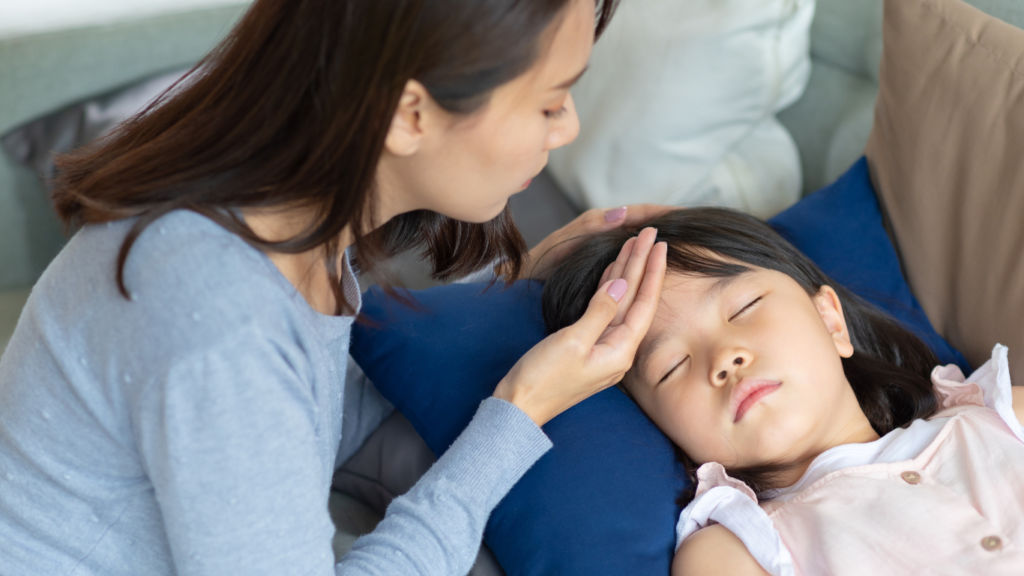
With such a different set of children’s migraine symptoms, it can be hard to know if your child’s headache is a migraine, allergy, sinus problem or eyesight issue. And what about those bouts of car sickness and intense tummy aches—are they migraines?
Because migraines are so different for children, it’s critical to work with your doctor to identify what’s causing symptoms as quickly as possible. Using a migraine diary, as mentioned above, is an excellent first step. The information you log into the diary will provide critical insights into what triggers, symptoms and patterns seem to be in play.
With a natural approach to pediatric migraine treatment, your doctor can create a plan not just for managing your child’s migraines, but helping to prevent them before attacks occur.
Sources
- Szperka C. Headache in Children and Adolescents. Continuum (Minneap Minn). 2021 Jun 01;27(3):703-731. [PMC free article] [PubMed] (2023, May 9). Ocular Migraine. Cleveland Clinic: Diseases and Conditions. https://my.clevelandclinic.org/health/diseases/24961-ocular-migraine
- Robertson, W., Jr., & Kao, A. (2019, August 5). Migraine in Children. MedScape Neurology. https://emedicine.medscape.com/article/1179268-overview#:~:text=Only%2010%2D20%25%20of%20children,are%20unable%20to%20describe%20it.
- Mani, J. M., ., & Madani, S. (n.d.). Pediatric abdominal migraine: Current perspectives on a lesser known entity. PubMed Central (PMC). https://www.ncbi.nlm.nih.gov/pmc/articles/PMC5923275/
- Hershey AD, Powers SW, Bentti AL, Degrauw TJ. Effectiveness of amitriptyline in the prophylactic management of childhood headaches. Headache. (2000) 40:539–49. 10.1046/j.1526-4610.2000.00085.x [PubMed] [CrossRef] [Google Scholar] [Ref list]
- Use of cyproheptadine to stimulate appetite and body weight gain: a systematic review. Harrison ME, Norris ML, Robinson A, Spettigue W, Morrissey M, Isserlin L. Appetite. 2019;137:62–72. [PubMed] [Google Scholar] [Ref list]

Natural Remedies
2 Aug 2024
5 min read
Can weather cause migraine headaches? A forecast for fewer headache days
For centuries, individuals afflicted with migraines have reported a curious phenomenon: their headaches seem to wax and wane with changes in the weather. From the onset of a storm, to shifts in temperature, humidity or barometric pressure, the connection between migraine and weather has long captured the attention of scientists and sufferers alike. In this […]

Alternative Therapies
2 Aug 2024
7 min read
Understanding the Complex Relationship Between Migraine and Hormones
Among Americans, 17.1% of women and 5.6% of men suffer migraines.1 Both genders often experience a link between their migraines and hormone shifts. A growing body of research suggests that both male and female sex hormones could influence the course of tension-type and migraine headaches. What hormones are involved and how can these hormone migraines be managed? […]

Alternative Therapies
2 Aug 2024
9 min read
Understanding Migraines in Children: Symptoms, Impact and Treatments
Migraines are often perceived as an adult ailment, but migraines in children do occur. In fact, about 1 in 10 children experience recurrent headaches due to migraine. Symptoms of up to 18% of patients in the pediatric emergency room are found to be migraine-related.1 However, childhood and adolescent migraines look different than adult migraine — […]

